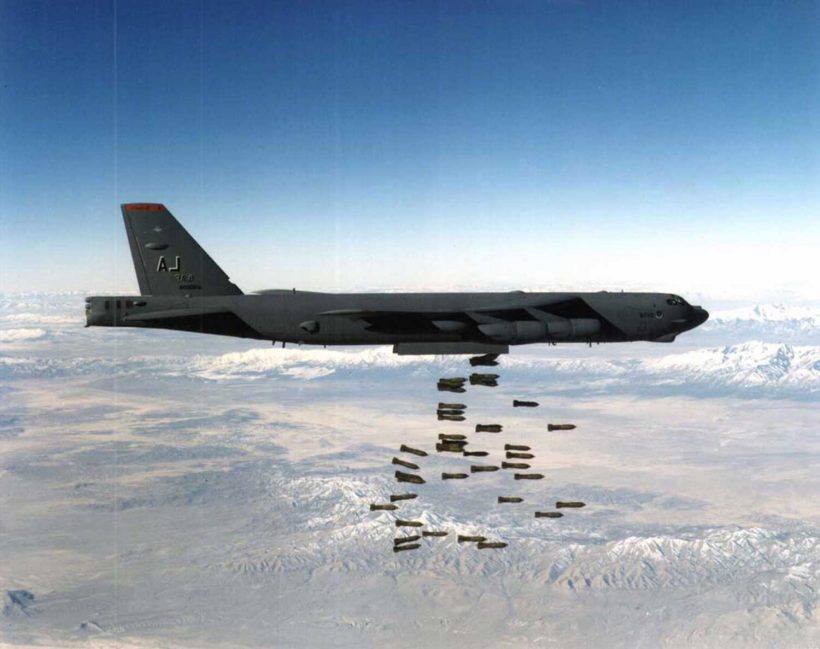HUGE B-52 bombers and aircraft carrier are being sent to the Middle East as a warning to the Taliban.
The Pentagon has deployed the aerial bombers in the region to support the withdrawal of US troops from Afghanistan, spokesman John Kirby said on Friday.
"I would advise the Taliban that we will be well-prepared to defend ourselves throughout the withdrawal process," Gen. Frank McKenzie, the head of US Central Command, told the Pentagon.
However, it's not clear whether further reinforcements could be sent to ensure the smooth and safe removal of some 2,500 US troops and another 16,000 civilians supporting America's operation in Afghanistan.
There are also another 7,000 NATO troops in the country, who also depend on the US for material and security support.
The move comes despite Gen. McKenzie joining senior generals to advise Joe Biden's administration against a complete withdrawal from Afghanistan.
Lloyd Austin, the defense secretary, and Mark Milley, chairman of the joint chiefs of staff, suggested leaving a counterterrorist force to boost the Kabul government after the US quits the landlocked country.
But, the US President confirmed that America will withdraw all of its troops from Afghanistan by September 11, 2021 to end "the longest war in US history".
The Taliban had insisted that Washington stick to a February 2020 agreement the militants had reached with Donald Trump's administration to complete the US withdrawal by May 1.
US officials said after Biden's announcement that extra military personnel would likely be positioned in Afghanistan to support the pullout of troops and gear.
Air Force B-52 bombers have already arrived in the region as part of the pre-pullout bolstering of security, said defense spokesman John Kirby.
Defense Secretary Lloyd Austin decided to keep an aircraft carrier in the Middle East to help provide protection for American and coalition troops during their planned withdrawal from Afghanistan in coming weeks.
Austin has approved an extension of the USS Dwight D. Eisenhower's deployment in the Middle East for a period of time.
"And he has approved the addition of some long range bombers to be deployed to the region. Two of those B-52s have arrived in the region," Kirby confirmed.
The Stratofortress bombers are usually based in Qatar, where the US military has a major base.
"I think it's reasonable to assume that there could be temporary additional force protection measures and enablers that we would require to make sure that this drawdown goes smoothly and safely for our men and women," Kirby told reporters.
"It would be foolhardy and imprudent not to assume that there could be resistance and opposition to the drawdown by the Taliban, given their staunch rhetoric", Kirby added.
He said the withdrawal plan was discussed at a meeting Friday of defense bosses.
The Times in the UK reports that America has sought the go-ahead to base drones and special forces in countries neighboring Afghanistan.
This is due to fears that Kabul's military would collapse against the Taliban upon the removal of foreign troops.
The Taliban has about 60,000 fighters, according to latest figures.
Gen. McKenzie admitted: "I am concerned about the ability of the Afghan military to hold on after we leave, the ability of the Aghan air force to fly – in particular – after we remove the support for those aircraft."
The Afghan air force has just 34 "combat-capable" planes and five attack choppers says London-based Institute for Strategic Studies.
Gen. McKenzie told officials that the Taliban might need to be kept at bay from a 'floating' force.
The Times adds: "This would suggest a naval presence in the Arabian Sea, which is 300 miles south of Afghanistan, on a more permanent basis."
The removal of thousands of American troops will coincide with the 20th anniversary of the September 11, 2001 terrorist attacks.
AMERICA’s operations in Afghanistan – launched after the 9/11 attacks – have come at great cost.
19: Years since war against al-Qaeda and the Taliban started in October 2001.
2,305: Number of US personnel who have died in Afghanistan since 2001.
20,320: Number of US personnel wounded in action.
110,000: Total number of US troops in Afghanistan at the height of deployment in 2011.
$778bn: Total US military expenditure in Afghanistan from 2001 to 2019. Another $44bn has gone on reconstruction projects.
Biden announced in mid-April: "It is time to end America’s longest war. It is time for American troops to come home."
"The United States will begin our final withdrawal on May 1 of this year. We will do it responsibly, deliberately, and safely."
Biden said the Taliban should know that the US will "defend our allies and partners with all the tools at our disposal," however.
The President added: "We went to Afghanistan because of a horrific attack that happened 20 years ago.
"That cannot explain why we should remain there in 2021."
Biden said that the US must "focus on the challenge that are in front of us," as he highlighted tensions with China, "cyber threats" in 2021, and the need to strengthen global health care in light of the Covid pandemic.
However, Donald Trump urged Biden to remove troops quickly.
The former president said the withdrawal should be done "earlier" than September 11, as he said the day should remain one of "reflection and remembrance."
"Getting out of Afghanistan is a wonderful and positive thing to do," he noted.
Source: Read Full Article









